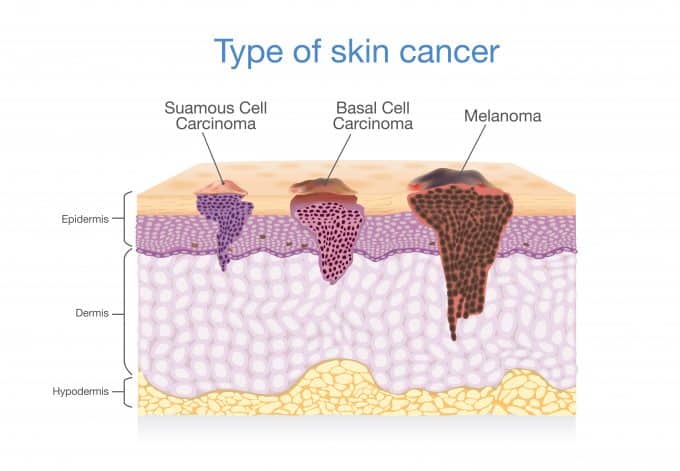Farmington Derm Fights Skin Cancer

The American Academy of Dermatology is encouraging individuals to perform regular self-skin exams for skin cancer because cancers like melanomas are detected by the patient. Unfortunately, skin cancer is very common in the U.S. Melanoma cancer rates have more than doubled and it is increasing. If there is a good report about skin cancer, it is that it’s detectable thus catching it early is a health benefit and a cure is more likely.
Common Skin Cancer Cells
There are three common types of skin cancer:
-
Squamous cell
Squamous cell skin cancer is most often caused by overexposure to solar rays. It also spreads quickly throughout the body. Squamous skin cancer can appear as follows:
- hard red nodule
- scaly flat lesion
-
Basal cell
Basal cell skin cancer is the most curable form. Per its name, skin cancer starts in the basal cells. This means that it is most evident in the face and areas of the skin that is over-exposed to the sun. It does not spread in the body like a squamous cell, but its presence in the skin is very disruptive to organs and tissues around its existence. Basal cell carcinoma can appear as follows:
- light waxy bump
- a flat lesion that is flesh-colored or looks like a brown scar
- a scabby sore that bleeds then heal and unfortunately returns
-
Melanoma
Melanoma is very aggressive. It begins in the hardest to reach body area which is in the pigment cells of the skin. It can appear anywhere on the body and it too spreads if not caught quickly. Melanoma can appear as follows:
- large brown spot with a dark pimple
- a mole that changes in color, size, texture or that bleeds
- a small abnormal lesion that appears red, pink, white, blue or blue-black in color
- a painful lesion that itches or burns
- dark lesions that appear on the palms, soles, fingertips, toes, mouth, or nose
A Soldier Against Skin Cancer
Unfortunately, yes there are other types of skin cancer. Skin cancer is an ongoing research quest with many physicians like Dr. David A. Baird seeking its demise. Dr. Baird in Farmington, Michigan is a board-certified dermatologist. He has been on the battlefield of fighting skin cancer for over 20 years.
Dr. Baird‘s skin cancer conquest is through detection, diagnosis, treatment, and maintenance. When you are looking for a compassionate physician who patiently answers all your worries, Dr. Baird is a dermatologist who explains the best medical procedures for you.
How Farmington Derm Treats Skin Cancer
In superficial skin cancer cases, Dr. Baird performs a skin biopsy. However, further treatment may be required. Surgical skin cancer options include the following:
- Curettage/Cryotherapy: Two procedures are accomplished using these procedures. In one instance a surgeon scrapes layers of cancer cells away. The other treatment is subjecting cancerous cells to a hot needle, followed by liquid nitrogen killing the remaining cells.
- Excisional Skin Surgery: The treatment area will be numbed, and the cancerous tissues and surrounding tissue will be removed with a scalpel.
- Mohs Surgery: When cancer returns a physician shaves it away in thin layers. This continues until there are no remaining cancer cells.
- Photodynamic Therapy (PDT): PDT is a type of prescription drug therapy that causes skin cells to become sensitive to light which is what it is exposed too until the cancer cells are destroyed.
Dr. Baird of Farmington Dermatologists says that their goal is close all wounds without compromising a person’s aesthetic appearance. If you suspect you have skin cancer, contact Farmington Dermatology today for a full examination.

